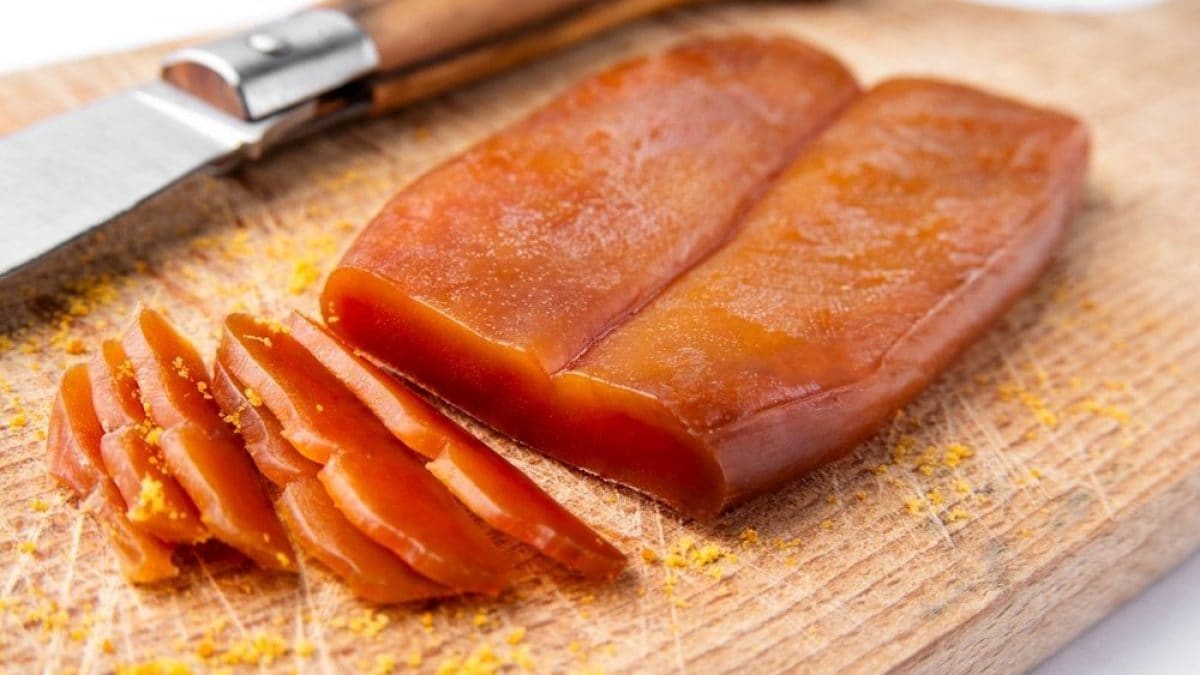
Bottarga (or, in English, ‘salted cured fish roe‘) is an increasingly popular specialty in the world of cooking, gourmet and otherwise: it is a truly unique, precious and sought-after fish product, so much so that it has been nicknamed the “caviar of the Mediterranean”. Just a sprinkling of it is enough to feel a real explosion of seafood flavor on your plate. Obtained by drying the eggs of certain types of fish – especially mullet, but not only – bottarga is an excellence, a delicacy. Let's find out everything there is to know about bottarga, all the types in which you can find it and how to best use it in your recipes.
What is Bottarga and What Is It Made From?
Bottarga is a very particular and highly sought-after fish product that is obtained by salting and drying the eggs of some species of fish, especially mullet but also tuna and swordfish. Typically produced in Italy (Sardinia, Tuscany, Sicily and Calabria) and also in Tunisia, bottarga is also produced in some parts of the U.S. (namely Florida and the West Coast), but is actually a very ancient tradition, which has its origins in the Sardinian Nuragic civilization (around 1800 BC): for a long time it represented the typical meal of fishermen, until it later became a true excellence, a fundamental ingredient of haute cuisine dishes.
What makes bottarga so prized is its production method, a long process that is a true art: it begins by extracting the ovarian sac of the female fish, then follows with a careful cleaning and then the eggs are salted. Once ready, they are dried for a period of at least 90 days in a complex system of wooden boards weighed down with stones. This is the general practice, but it varies based on the production area and the breed of fish from which the eggs are extracted.
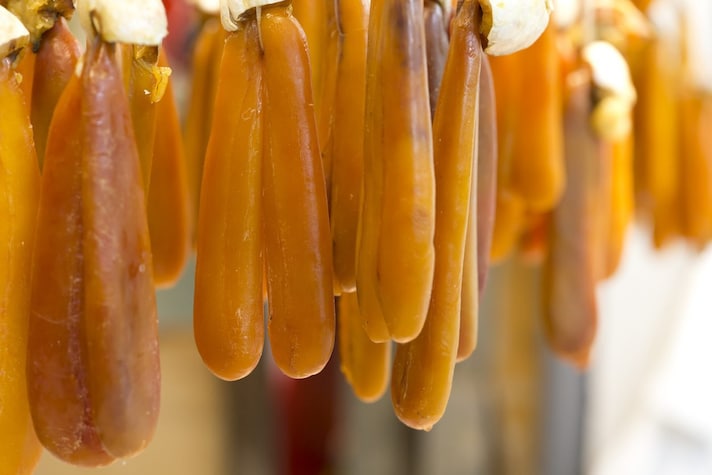
Once the process is complete, the bottarga is cleaned of excess salt and then sold in powder form, in a jar, at a cost that varies from 60 to 300 euros per kilogram. Today, bottarga is also offered whole, the result of a special process that allows it to be consumed either in slices, perhaps seasoned with extra virgin olive oil, or grated and used in powder form as per tradition.
In terms of taste, bottarga, especially the powdered one, has a very strong and decisive flavor, extremely salty, which is why you have to use it very sparingly: just a pinch is enough to have a real explosion of flavor in your mouth. It is used especially in main dishes, both those made from fish and simple spaghetti with garlic and chili pepper, which with bottarga take on a truly unique seafood flavor.
Types of Bottarga
A little-known piece of information about bottarga is that there are different types. The most famous is undoubtedly that of mullet, a great Italian excellence, but in reality there are several categories depending on the type of eggs from which the product is obtained. Each is a unique product, with different characteristics and variable flavors, each with its specific use in the culinary field.
Mullet Bottarga
Mullet bottarga is the most famous, most appreciated and most used variety of all the types of bottarga. Easy to identify for its amber color and its strong but delicate flavor at the same time, it is also nicknamed "the gold of Sardinia": the island, in fact, is the largest producer. The main production centers of this precious food are found in the central-western stretch of coast known as the Sinis Peninsula, but it is the Cabras lagoon that offers the best quality, so much so that Cabras bottarga has become an international excellence. A good production of mullet bottarga also exists in Tuscany, obtained from fish in the Orbetello Lagoon and already mentioned as a product at the end of the 15th century. Both can be enjoyed either pure, cut into thin slices, or in powder, grated in small quantities on fish-based first courses or to create spreadable creams based on vegetables such as courgettes, aubergines or artichokes.
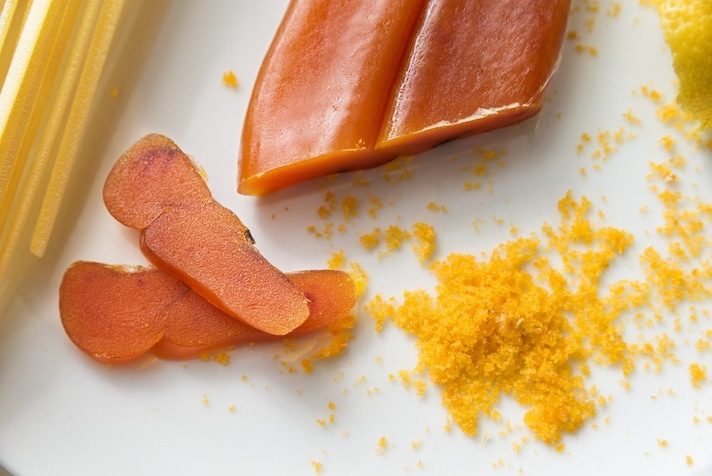
Tuna Bottarga
The second most common type is tuna bottarga, a specialty found mainly in Sicily (Trapani, Favignana, Pachino) and Calabria (in the province of Reggio), but also in some areas of Sardinia, particularly in the Carloforte area. In this case, the starting eggs are those of the tuna, which once extracted are transported to a dry place and placed under a weight for 3 or 4 days. Salting is done manually with a massage repeated daily for about ten days, after which it is dried for just over a month in dark, humidity-free rooms. Tuna bottarga is also an ancient tradition, born in the days of the tuna fisheries when tuna fishermen had the right to have the innards of the fish. Tuna bottarga is distinguished by its brown color and a much stronger flavor than that of mullet, which is why in all three production areas it is usually consumed on its own, sprinkled over spaghetti seasoned with cherry tomatoes and anchovies in Sardinia, with lemon in Sicily, and with black olives and chili pepper in Calabria.
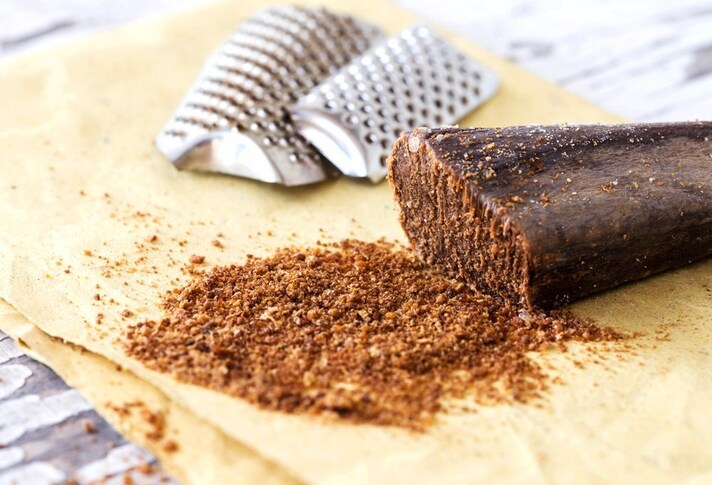
Swordfish Bottarga
In Sicily and Sardinia, another variety is produced, less known but no less excellent in terms of taste. It is swordfish bottarga, with a lighter color and a flavor that is halfway between the other types: in terms of intensity, it is halfway between the character of tuna bottarga and the delicacy of mullet bottarga. Precisely because of this lightness in terms of flavor, it gives its best when combined with other flavors, such as clams and Trapani-style pesto.
Other Types of Bottarga
In addition to the three main varieties, there are other types of bottarga, less famous and more tied to strictly local artisanal production: this is the case, for example, of the bottarga obtained from amberjack, that derived from dolphinfish and that produced from bonito eggs. A true rarity is the Spanish ling bottarga (hevas de maruca), a variety produced from a fish similar to cod caught at the mouth of the Mediterranean. It is a typically Spanish recipe, especially from the coastal area of the province of Alicante, but it is also found in Italy only and exclusively in Alghero: the city with Catalan roots, in fact, has specialized in this variant of bottarga with an even more delicate flavor than mullet eggs.
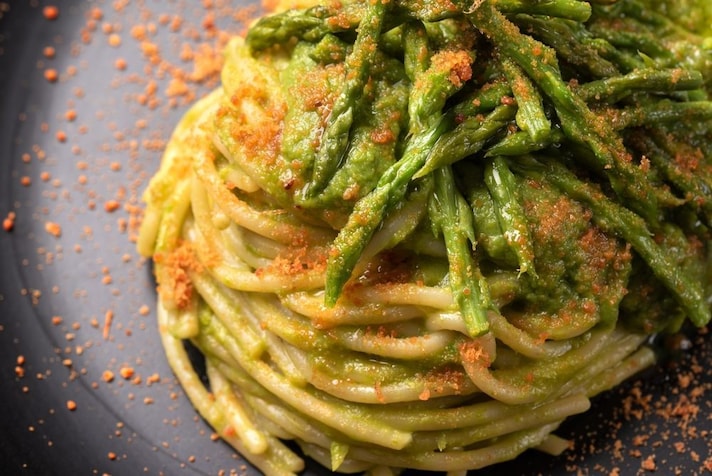
;Resize,width=767;)
